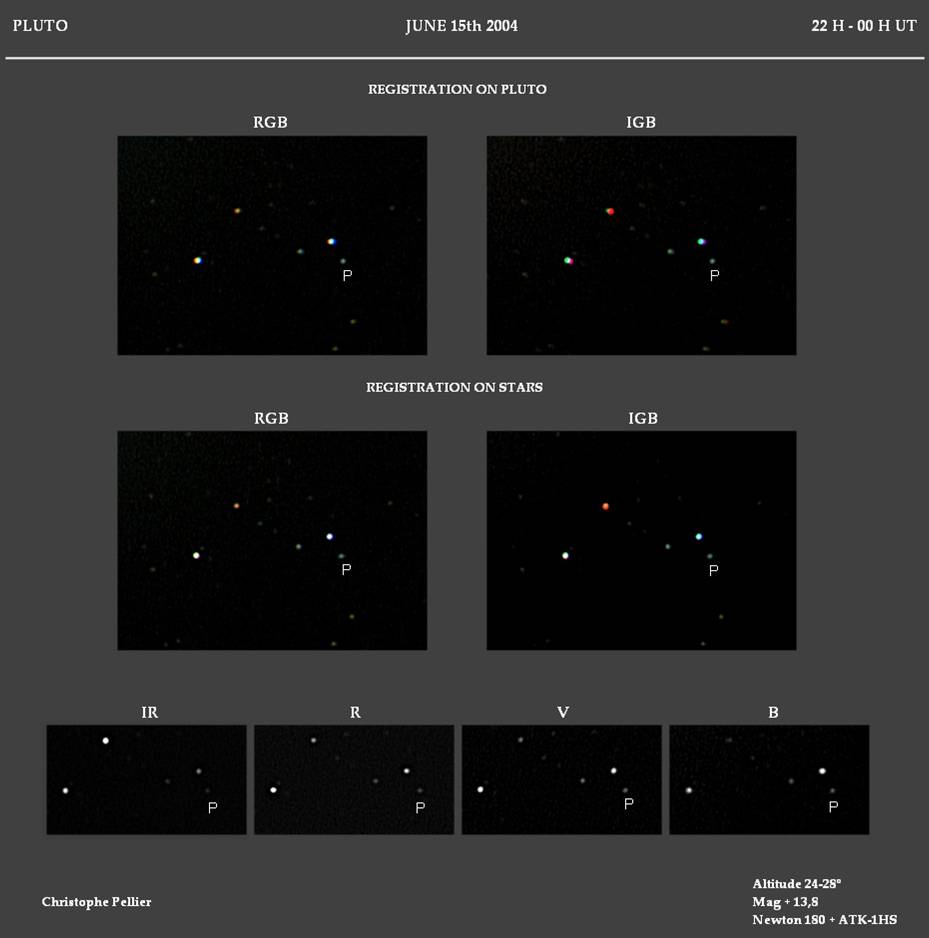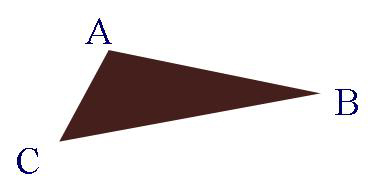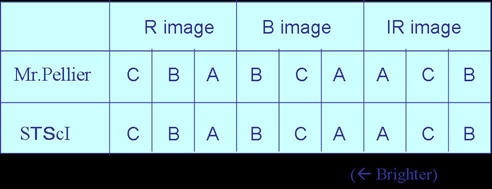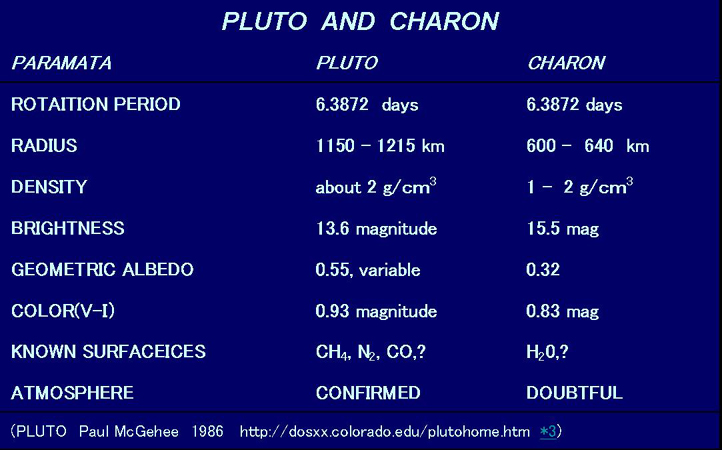ALPO-Japan-Meeting
What color is the planet Pluto?
17/Oct/2004
Toshiro Mishina
==============================================================================================
Abstract
In 15/june/2004, Mr. Christophe Pellier (in Paris) took the digital photograph of green-bluish Pluto.
(see his RGB or IGB images.)
Pluto was supposed to be yellowish in color 30year ago.
What color is the Planet Pluto?
I surveyed some information of Pluto on the internet.
(1) I cited the image of STScI*1 by way of comparison to the Pluto images taken by Mr. Pellier.
(2) Then I tried to confirm the color of Pluto at web pages on the internet.
1 Blue Pluto
This image of Pluto taken by Mr.Pellier seems to be bluish in color. There is a triangle of 3 stars near Pluto.
Those stars are red, blue, and yellow. I wanted to confirm the color of 3 stars by the spectral type. But I couldn't.
 1.1 Citing another monochromatic image by way of comparison
Therefore I cited another V,B,R images by way of comparison.
I took 3 images of "POSS2/UKSTU" from "The STScI Digitized Sky Survey"*1on the internet.
(RA:17h22m05.0 Dec:-14d16 Height:6.5 Width:4.5 minutes)
1.1 Citing another monochromatic image by way of comparison
Therefore I cited another V,B,R images by way of comparison.
I took 3 images of "POSS2/UKSTU" from "The STScI Digitized Sky Survey"*1on the internet.
(RA:17h22m05.0 Dec:-14d16 Height:6.5 Width:4.5 minutes)
 I looked into the brightness of 3 stars. Those stars are made a triangle on the under side of each 3 monochromatic
images.
(A : upper vertex B : right vertex C : left vertexj
I looked into the brightness of 3 stars. Those stars are made a triangle on the under side of each 3 monochromatic
images.
(A : upper vertex B : right vertex C : left vertexj

 In the R-image :(from blight side) C>B>A
In the B-image :(from blight side) B>C>A
In the IR- image :(from blight side) A>C>B
According to the left table, the sequence of 3 stars at the vertex of triangle in the images
(R,B,IR-images taken by Mr.Pellier
and R,B,IR-images on STScI ) are equal each to each.
I thought that the color of the 3 stars at the vertex of triangle are right. A is a "R" type star.
(Reason : A is the brightest of the IR-image.)
C is a "R" or "G" type star. (Reason: A brightest star, on the upper side of eachmonochromatic image,
is a "A3" type star.
The brightness of this "A3" type star in the R and the B-images are equal each to each. However,
C in the R-image is brighter than C in the B-image. Therefore C is a "K" or "G" type star.)
B is a "A" or "G" type star. (Reason: I supposed "C" to be a "A" or "G" type star in comparison
with the "A3" type star.)
It seems that 3 stars (red, blue, and yellow) at the vertex of the triangle in the RGB image taken
by Mr.Pellier is not inconsistent with the images in STScI.
Therefore the RGB image taken by Mr.Pellier has the right color images.
2 Pluto in the websites
2.1 Image of Pluto taken with a CCD camera at Cerro Tololo Inter American Observatory
There is an animation image of Pluto in "SOLA SYSYTEM ASTROPHOTOGRAPHY" *2 on the internet.
This animation image shows the motion of Pluto. This image of Pluto is supposed to be bluish in color.
Animation of Pluto in "SOLA SYSYTEM ASTROPHOTOGRAPHY"
1 Please click to "SOLA SYSTEM ASTROGRAPHY"
2 Please scroll down to the animation image of Pluto
2.2 "PLUTE" at University of Colorado web page.
"PLUTE" *3 at University of Colorado website is published by Prof. Fran Bagenal who is a professor of
the Astrophysical
and Planetary Sciences Department of the University.
There is a figure of 9 Planets in "PLUTE" *3. In this figure, Pluto and Caron are in bluish color. Therefore
I expect that Pluto and Caron are both bluish in color.
9 Planets images in "PLUTE"
Please click to "PLUTE"
There are astronomical data of Pluto and Caron in "PLUTO".
From this table,
(1) Pluto has a thin atmosphere.
(2) The color index (V-I) of Caron is smaller than the color index (V-I) of Pluto.
This means that Charon is bluer than Pluto. And in the figure of 9 Planets in "Pluto" , Charon is bluer than Pluto.
(ex. "0.93" and"0.83"(color index (V-I) are included "G" spectral type.)
In the R-image :(from blight side) C>B>A
In the B-image :(from blight side) B>C>A
In the IR- image :(from blight side) A>C>B
According to the left table, the sequence of 3 stars at the vertex of triangle in the images
(R,B,IR-images taken by Mr.Pellier
and R,B,IR-images on STScI ) are equal each to each.
I thought that the color of the 3 stars at the vertex of triangle are right. A is a "R" type star.
(Reason : A is the brightest of the IR-image.)
C is a "R" or "G" type star. (Reason: A brightest star, on the upper side of eachmonochromatic image,
is a "A3" type star.
The brightness of this "A3" type star in the R and the B-images are equal each to each. However,
C in the R-image is brighter than C in the B-image. Therefore C is a "K" or "G" type star.)
B is a "A" or "G" type star. (Reason: I supposed "C" to be a "A" or "G" type star in comparison
with the "A3" type star.)
It seems that 3 stars (red, blue, and yellow) at the vertex of the triangle in the RGB image taken
by Mr.Pellier is not inconsistent with the images in STScI.
Therefore the RGB image taken by Mr.Pellier has the right color images.
2 Pluto in the websites
2.1 Image of Pluto taken with a CCD camera at Cerro Tololo Inter American Observatory
There is an animation image of Pluto in "SOLA SYSYTEM ASTROPHOTOGRAPHY" *2 on the internet.
This animation image shows the motion of Pluto. This image of Pluto is supposed to be bluish in color.
Animation of Pluto in "SOLA SYSYTEM ASTROPHOTOGRAPHY"
1 Please click to "SOLA SYSTEM ASTROGRAPHY"
2 Please scroll down to the animation image of Pluto
2.2 "PLUTE" at University of Colorado web page.
"PLUTE" *3 at University of Colorado website is published by Prof. Fran Bagenal who is a professor of
the Astrophysical
and Planetary Sciences Department of the University.
There is a figure of 9 Planets in "PLUTE" *3. In this figure, Pluto and Caron are in bluish color. Therefore
I expect that Pluto and Caron are both bluish in color.
9 Planets images in "PLUTE"
Please click to "PLUTE"
There are astronomical data of Pluto and Caron in "PLUTO".
From this table,
(1) Pluto has a thin atmosphere.
(2) The color index (V-I) of Caron is smaller than the color index (V-I) of Pluto.
This means that Charon is bluer than Pluto. And in the figure of 9 Planets in "Pluto" , Charon is bluer than Pluto.
(ex. "0.93" and"0.83"(color index (V-I) are included "G" spectral type.)
 3 Summary
(1) I accept the images of Pluto taken by Mr.Pellier as true. Then Pluto is bluish in color.
(2) I couldn't confirm the color of Pluto at the websites on the internet.
But I found two websites on the internet to mean that Pluto is bluish in color.
4 A survey of the future observation of Pluto
The photograph of Pluto taken by Mr. Pellier show that "the color of Pluto" are able to be observed by
the amateur astronomers with over 20cm telescope and some digital image equipments. this means that a
new observational object appeared in front of the amateur astronomers.
The easiest method to observe the color of Pluto is the digital camera photography. I think that we can
evaluate the color of Pluto with the digital camera photography at Dark-Sky-Sites where we carry over 20cm
telescope. More nice method to observe the color of Pluto is the processing for some astronomical CCD
images. And I think that someone can observe the color of Pluto with their naked eyes through over 1m
telescope at the Observatory for public use.
Many amateur astronomers will plane the various themes and methods for "Observing the color of Pluto" .
---Example : "A color variation with rotation of Pluto". etc.
I think that many amateur astronomers can enjoy planning the original method and finding original theme for
observation of the color of Pluto.
Merci beaucoup pour la photo de Pluto, monsieur Pellier!
(Many thanks for a photo of Pluto, Mr.Pellier!)
Reference
*1 The STScI Digitized Sky Survey http://archive.stsci.edu/cgi-bin/dss_form?
*2 SOLASYSYTEMASTROPHOTOGRAPHY
http://www.chara.gsu.edu/~subasavage/astrophot.html
*3 PLUTO Paul McGehee 1986 http://dosxx.colorado.edu/plutohome.html
Internet websites
(a) Pluto and Caron Thralow, Inc, 2003 http://www.the-planet-pluto.com/pluto-overview.html
(b) Pluto by Rosanna L. Hamilton 1998 http://solarviews.com/eng/pluto.htm
(c) Tohsiro Mishina 2004
3 Summary
(1) I accept the images of Pluto taken by Mr.Pellier as true. Then Pluto is bluish in color.
(2) I couldn't confirm the color of Pluto at the websites on the internet.
But I found two websites on the internet to mean that Pluto is bluish in color.
4 A survey of the future observation of Pluto
The photograph of Pluto taken by Mr. Pellier show that "the color of Pluto" are able to be observed by
the amateur astronomers with over 20cm telescope and some digital image equipments. this means that a
new observational object appeared in front of the amateur astronomers.
The easiest method to observe the color of Pluto is the digital camera photography. I think that we can
evaluate the color of Pluto with the digital camera photography at Dark-Sky-Sites where we carry over 20cm
telescope. More nice method to observe the color of Pluto is the processing for some astronomical CCD
images. And I think that someone can observe the color of Pluto with their naked eyes through over 1m
telescope at the Observatory for public use.
Many amateur astronomers will plane the various themes and methods for "Observing the color of Pluto" .
---Example : "A color variation with rotation of Pluto". etc.
I think that many amateur astronomers can enjoy planning the original method and finding original theme for
observation of the color of Pluto.
Merci beaucoup pour la photo de Pluto, monsieur Pellier!
(Many thanks for a photo of Pluto, Mr.Pellier!)
Reference
*1 The STScI Digitized Sky Survey http://archive.stsci.edu/cgi-bin/dss_form?
*2 SOLASYSYTEMASTROPHOTOGRAPHY
http://www.chara.gsu.edu/~subasavage/astrophot.html
*3 PLUTO Paul McGehee 1986 http://dosxx.colorado.edu/plutohome.html
Internet websites
(a) Pluto and Caron Thralow, Inc, 2003 http://www.the-planet-pluto.com/pluto-overview.html
(b) Pluto by Rosanna L. Hamilton 1998 http://solarviews.com/eng/pluto.htm
(c) Tohsiro Mishina 2004
 1.1 Citing another monochromatic image by way of comparison
Therefore I cited another V,B,R images by way of comparison.
I took 3 images of "POSS2/UKSTU" from "The STScI Digitized Sky Survey"*1on the internet.
(RA:17h22m05.0 Dec:-14d16 Height:6.5 Width:4.5 minutes)
1.1 Citing another monochromatic image by way of comparison
Therefore I cited another V,B,R images by way of comparison.
I took 3 images of "POSS2/UKSTU" from "The STScI Digitized Sky Survey"*1on the internet.
(RA:17h22m05.0 Dec:-14d16 Height:6.5 Width:4.5 minutes)
 I looked into the brightness of 3 stars. Those stars are made a triangle on the under side of each 3 monochromatic
images.
(A : upper vertex B : right vertex C : left vertexj
I looked into the brightness of 3 stars. Those stars are made a triangle on the under side of each 3 monochromatic
images.
(A : upper vertex B : right vertex C : left vertexj

 In the R-image :(from blight side) C>B>A
In the B-image :(from blight side) B>C>A
In the IR- image :(from blight side) A>C>B
According to the left table, the sequence of 3 stars at the vertex of triangle in the images
(R,B,IR-images taken by Mr.Pellier
and R,B,IR-images on STScI ) are equal each to each.
I thought that the color of the 3 stars at the vertex of triangle are right. A is a "R" type star.
(Reason : A is the brightest of the IR-image.)
C is a "R" or "G" type star. (Reason: A brightest star, on the upper side of eachmonochromatic image,
is a "A3" type star.
The brightness of this "A3" type star in the R and the B-images are equal each to each. However,
C in the R-image is brighter than C in the B-image. Therefore C is a "K" or "G" type star.)
B is a "A" or "G" type star. (Reason: I supposed "C" to be a "A" or "G" type star in comparison
with the "A3" type star.)
It seems that 3 stars (red, blue, and yellow) at the vertex of the triangle in the RGB image taken
by Mr.Pellier is not inconsistent with the images in STScI.
Therefore the RGB image taken by Mr.Pellier has the right color images.
2 Pluto in the websites
2.1 Image of Pluto taken with a CCD camera at Cerro Tololo Inter American Observatory
There is an animation image of Pluto in "SOLA SYSYTEM ASTROPHOTOGRAPHY" *2 on the internet.
This animation image shows the motion of Pluto. This image of Pluto is supposed to be bluish in color.
Animation of Pluto in "SOLA SYSYTEM ASTROPHOTOGRAPHY"
1 Please click to "SOLA SYSTEM ASTROGRAPHY"
2 Please scroll down to the animation image of Pluto
2.2 "PLUTE" at University of Colorado web page.
"PLUTE" *3 at University of Colorado website is published by Prof. Fran Bagenal who is a professor of
the Astrophysical
and Planetary Sciences Department of the University.
There is a figure of 9 Planets in "PLUTE" *3. In this figure, Pluto and Caron are in bluish color. Therefore
I expect that Pluto and Caron are both bluish in color.
9 Planets images in "PLUTE"
Please click to "PLUTE"
There are astronomical data of Pluto and Caron in "PLUTO".
From this table,
(1) Pluto has a thin atmosphere.
(2) The color index (V-I) of Caron is smaller than the color index (V-I) of Pluto.
This means that Charon is bluer than Pluto. And in the figure of 9 Planets in "Pluto" , Charon is bluer than Pluto.
(ex. "0.93" and"0.83"(color index (V-I) are included "G" spectral type.)
In the R-image :(from blight side) C>B>A
In the B-image :(from blight side) B>C>A
In the IR- image :(from blight side) A>C>B
According to the left table, the sequence of 3 stars at the vertex of triangle in the images
(R,B,IR-images taken by Mr.Pellier
and R,B,IR-images on STScI ) are equal each to each.
I thought that the color of the 3 stars at the vertex of triangle are right. A is a "R" type star.
(Reason : A is the brightest of the IR-image.)
C is a "R" or "G" type star. (Reason: A brightest star, on the upper side of eachmonochromatic image,
is a "A3" type star.
The brightness of this "A3" type star in the R and the B-images are equal each to each. However,
C in the R-image is brighter than C in the B-image. Therefore C is a "K" or "G" type star.)
B is a "A" or "G" type star. (Reason: I supposed "C" to be a "A" or "G" type star in comparison
with the "A3" type star.)
It seems that 3 stars (red, blue, and yellow) at the vertex of the triangle in the RGB image taken
by Mr.Pellier is not inconsistent with the images in STScI.
Therefore the RGB image taken by Mr.Pellier has the right color images.
2 Pluto in the websites
2.1 Image of Pluto taken with a CCD camera at Cerro Tololo Inter American Observatory
There is an animation image of Pluto in "SOLA SYSYTEM ASTROPHOTOGRAPHY" *2 on the internet.
This animation image shows the motion of Pluto. This image of Pluto is supposed to be bluish in color.
Animation of Pluto in "SOLA SYSYTEM ASTROPHOTOGRAPHY"
1 Please click to "SOLA SYSTEM ASTROGRAPHY"
2 Please scroll down to the animation image of Pluto
2.2 "PLUTE" at University of Colorado web page.
"PLUTE" *3 at University of Colorado website is published by Prof. Fran Bagenal who is a professor of
the Astrophysical
and Planetary Sciences Department of the University.
There is a figure of 9 Planets in "PLUTE" *3. In this figure, Pluto and Caron are in bluish color. Therefore
I expect that Pluto and Caron are both bluish in color.
9 Planets images in "PLUTE"
Please click to "PLUTE"
There are astronomical data of Pluto and Caron in "PLUTO".
From this table,
(1) Pluto has a thin atmosphere.
(2) The color index (V-I) of Caron is smaller than the color index (V-I) of Pluto.
This means that Charon is bluer than Pluto. And in the figure of 9 Planets in "Pluto" , Charon is bluer than Pluto.
(ex. "0.93" and"0.83"(color index (V-I) are included "G" spectral type.)
 3 Summary
(1) I accept the images of Pluto taken by Mr.Pellier as true. Then Pluto is bluish in color.
(2) I couldn't confirm the color of Pluto at the websites on the internet.
But I found two websites on the internet to mean that Pluto is bluish in color.
4 A survey of the future observation of Pluto
The photograph of Pluto taken by Mr. Pellier show that "the color of Pluto" are able to be observed by
the amateur astronomers with over 20cm telescope and some digital image equipments. this means that a
new observational object appeared in front of the amateur astronomers.
The easiest method to observe the color of Pluto is the digital camera photography. I think that we can
evaluate the color of Pluto with the digital camera photography at Dark-Sky-Sites where we carry over 20cm
telescope. More nice method to observe the color of Pluto is the processing for some astronomical CCD
images. And I think that someone can observe the color of Pluto with their naked eyes through over 1m
telescope at the Observatory for public use.
Many amateur astronomers will plane the various themes and methods for "Observing the color of Pluto" .
---Example : "A color variation with rotation of Pluto". etc.
I think that many amateur astronomers can enjoy planning the original method and finding original theme for
observation of the color of Pluto.
Merci beaucoup pour la photo de Pluto, monsieur Pellier!
(Many thanks for a photo of Pluto, Mr.Pellier!)
Reference
*1 The STScI Digitized Sky Survey http://archive.stsci.edu/cgi-bin/dss_form?
*2 SOLASYSYTEMASTROPHOTOGRAPHY
http://www.chara.gsu.edu/~subasavage/astrophot.html
*3 PLUTO Paul McGehee 1986 http://dosxx.colorado.edu/plutohome.html
Internet websites
(a) Pluto and Caron Thralow, Inc, 2003 http://www.the-planet-pluto.com/pluto-overview.html
(b) Pluto by Rosanna L. Hamilton 1998 http://solarviews.com/eng/pluto.htm
(c) Tohsiro Mishina 2004
3 Summary
(1) I accept the images of Pluto taken by Mr.Pellier as true. Then Pluto is bluish in color.
(2) I couldn't confirm the color of Pluto at the websites on the internet.
But I found two websites on the internet to mean that Pluto is bluish in color.
4 A survey of the future observation of Pluto
The photograph of Pluto taken by Mr. Pellier show that "the color of Pluto" are able to be observed by
the amateur astronomers with over 20cm telescope and some digital image equipments. this means that a
new observational object appeared in front of the amateur astronomers.
The easiest method to observe the color of Pluto is the digital camera photography. I think that we can
evaluate the color of Pluto with the digital camera photography at Dark-Sky-Sites where we carry over 20cm
telescope. More nice method to observe the color of Pluto is the processing for some astronomical CCD
images. And I think that someone can observe the color of Pluto with their naked eyes through over 1m
telescope at the Observatory for public use.
Many amateur astronomers will plane the various themes and methods for "Observing the color of Pluto" .
---Example : "A color variation with rotation of Pluto". etc.
I think that many amateur astronomers can enjoy planning the original method and finding original theme for
observation of the color of Pluto.
Merci beaucoup pour la photo de Pluto, monsieur Pellier!
(Many thanks for a photo of Pluto, Mr.Pellier!)
Reference
*1 The STScI Digitized Sky Survey http://archive.stsci.edu/cgi-bin/dss_form?
*2 SOLASYSYTEMASTROPHOTOGRAPHY
http://www.chara.gsu.edu/~subasavage/astrophot.html
*3 PLUTO Paul McGehee 1986 http://dosxx.colorado.edu/plutohome.html
Internet websites
(a) Pluto and Caron Thralow, Inc, 2003 http://www.the-planet-pluto.com/pluto-overview.html
(b) Pluto by Rosanna L. Hamilton 1998 http://solarviews.com/eng/pluto.htm
(c) Tohsiro Mishina 2004